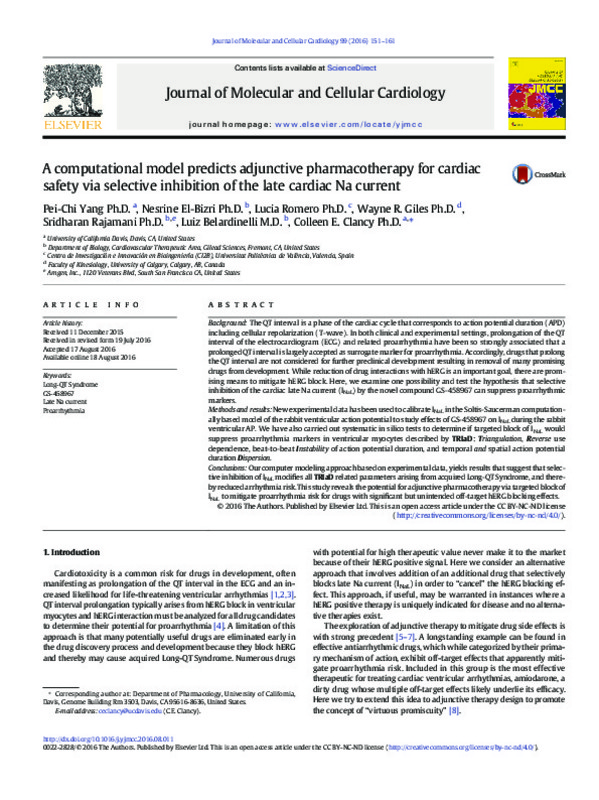JavaScript is disabled for your browser. Some features of this site may not work without it.
Buscar en RiuNet
Listar
Mi cuenta
Estadísticas
Ayuda RiuNet
Admin. UPV
A computational model predicts adjunctive pharmacotherapy for cardiac safety via selective inhibition of the late cardiac Na current
Mostrar el registro sencillo del ítem
Ficheros en el ítem
| dc.contributor.author | Yang, Pei-Chi
|
es_ES |
| dc.contributor.author | El-Bizri, Nesrine
|
es_ES |
| dc.contributor.author | Romero Pérez, Lucia
|
es_ES |
| dc.contributor.author | Giles, Wayne
|
es_ES |
| dc.contributor.author | Rajamani, Sridharan
|
es_ES |
| dc.contributor.author | Belardinelli, Luiz
|
es_ES |
| dc.contributor.author | Clancy, Colleen E
|
es_ES |
| dc.date.accessioned | 2018-05-13T04:24:55Z | |
| dc.date.available | 2018-05-13T04:24:55Z | |
| dc.date.issued | 2016 | es_ES |
| dc.identifier.issn | 0022-2828 | es_ES |
| dc.identifier.uri | http://hdl.handle.net/10251/101848 | |
| dc.description.abstract | [EN] Background: The QT interval is a phase of the cardiac cycle that corresponds to action potential duration (APD) including cellular repolarization (T-wave). In both clinical and experimental settings, prolongation of the QT interval of the electrocardiogram (ECG) and related proarrhythmia have been so strongly associated that a prolonged QT interval is largely accepted as surrogate marker for proarrhythmia. Accordingly, drugs that prolong the QT interval are not considered for further preclinical development resulting in removal of many promising drugs from development. While reduction of drug interactions with hERG is an important goal, there are promising means to mitigate hERG block. Here, we examine one possibility and test the hypothesis that selective inhibition of the cardiac late Na current (I-NaL) by the novel compound GS-458967 can suppress proarrhythmic markers. Methods and results: New experimental data has been used to calibrate INaL in the Soltis-Saucerman computationally based model of the rabbit ventricular action potential to study effects of GS-458967 on INaL during the rabbit ventricular AP. We have also carried out systematic in silico tests to determine if targeted block of INaL would suppress proarrhythmia markers in ventricular myocytes described by TRIaD: Triangulation, Reverse use dependence, beat-to-beat Instability of action potential duration, and temporal and spatial action potential duration Dispersion. Conclusions: Our computer modeling approach based on experimental data, yields results that suggest that selective inhibition of INaL modifies all TRIaD related parameters arising from acquired Long-QT Syndrome, and thereby reduced arrhythmia risk. This study reveals the potential for adjunctive pharmacotherapy via targeted block of INaL to mitigate proarrhythmia risk for drugs with significant but unintended off-target hERG blocking effects. | es_ES |
| dc.description.sponsorship | The National Institutes of Health R01 HL128537-01 (CEC), U01 HL126273-01 (CEC) and R01HL128170-02 (CEC). | es_ES |
| dc.language | Inglés | es_ES |
| dc.publisher | Elsevier | es_ES |
| dc.relation.ispartof | Journal of Molecular and Cellular Cardiology | es_ES |
| dc.rights | Reconocimiento - No comercial - Sin obra derivada (by-nc-nd) | es_ES |
| dc.subject | Long-QT Syndrome | es_ES |
| dc.subject | GS-458967 | es_ES |
| dc.subject | Late Na current | es_ES |
| dc.subject | Proarrhythmia | es_ES |
| dc.subject.classification | TECNOLOGIA ELECTRONICA | es_ES |
| dc.title | A computational model predicts adjunctive pharmacotherapy for cardiac safety via selective inhibition of the late cardiac Na current | es_ES |
| dc.type | Artículo | es_ES |
| dc.identifier.doi | 10.1016/j.yjmcc.2016.08.011 | es_ES |
| dc.relation.projectID | info:eu-repo/grantAgreement/NIH/NATIONAL HEART, LUNG, AND BLOOD INSTITUTE/5U01HL126273-04/US/ | en_EN |
| dc.relation.projectID | info:eu-repo/grantAgreement/NIH/NATIONAL HEART, LUNG, AND BLOOD INSTITUTE/1R01HL128170-01/US/ | |
| dc.rights.accessRights | Abierto | es_ES |
| dc.contributor.affiliation | Universitat Politècnica de València. Departamento de Ingeniería Electrónica - Departament d'Enginyeria Electrònica | es_ES |
| dc.description.bibliographicCitation | Yang, P.; El-Bizri, N.; Romero Pérez, L.; Giles, W.; Rajamani, S.; Belardinelli, L.; Clancy, CE. (2016). A computational model predicts adjunctive pharmacotherapy for cardiac safety via selective inhibition of the late cardiac Na current. Journal of Molecular and Cellular Cardiology. 99:151-161. https://doi.org/10.1016/j.yjmcc.2016.08.011 | es_ES |
| dc.description.accrualMethod | S | es_ES |
| dc.relation.publisherversion | https://doi.org/10.1016/j.yjmcc.2016.08.011 | es_ES |
| dc.description.upvformatpinicio | 151 | es_ES |
| dc.description.upvformatpfin | 161 | es_ES |
| dc.type.version | info:eu-repo/semantics/publishedVersion | es_ES |
| dc.description.volume | 99 | es_ES |
| dc.identifier.pmid | 27545042 | en_EN |
| dc.identifier.pmcid | PMC5453509 | en_EN |
| dc.relation.pasarela | S\333163 | es_ES |








